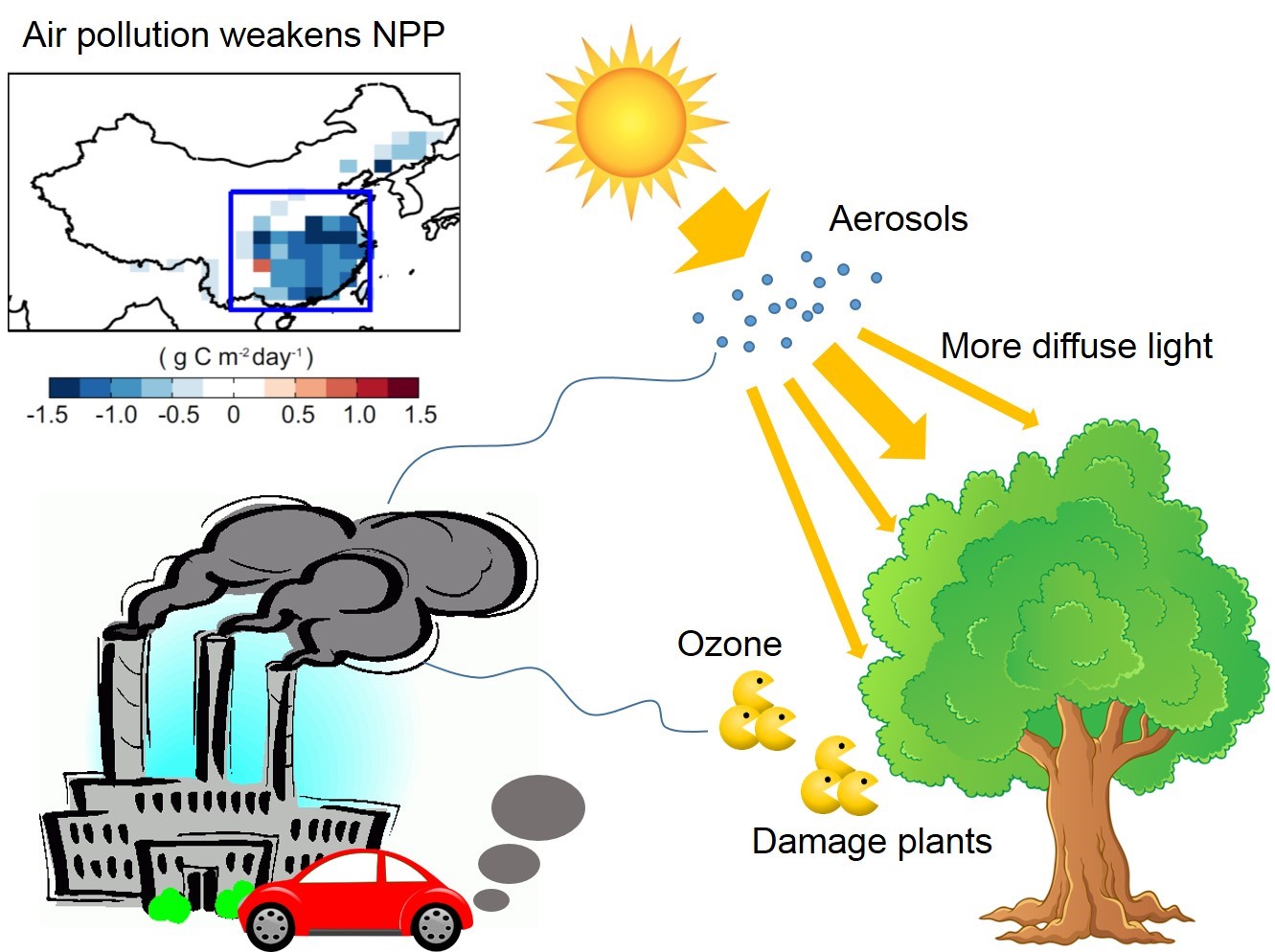Ozone and Haze Pollution Weakens Land Carbon Uptake in China
Date:2017-05-17
Toxic air pollution is a serious side effect of the rapid economic development in China. While it is widely recognized that air pollutants adversely affect human health and climate change, their impacts on the regional carbon balance are less well understood. Ozone reduces plant photosynthesis directly through stomatal uptake. Atmospheric aerosols often benefit plant photosynthesis through perturbations to radiation, meteorology, and cloud.

Anthropogenic emissions generate aerosols and surface ozone. Ozone is detrimental to plant health while aerosol is beneficial for photosynthesis because it increases light availability of lower canopy through scattering. The net effect of ozone and aerosol is an inhibition of NPP in China. (Image by YUE Xu)
Recently, a study led by Dr. YUE Xu from CAS Institute of Atmospheric Physics provides the first systematic assessment of the effects of ozone and aerosol haze pollution on terrestrial ecosystem health and land carbon assimilation in China, for the present day and two possible future scenarios. The calculations have been performed using state-of-the-science Earth system modeling that facilitates coupled simulation of the land biosphere, atmospheric chemistry, aerosol, and meteorology components, allowing the coherent treatment of interactions and feedbacks.
Results show that surface ozone and anthropogenic aerosol haze pollution in China together decrease the regional net primary productivity (NPP) by 0.4-0.8 petagrams of carbon (Pg C) per year, accounting for 9-16% of the total NPP of land ecosystems and 16-32% of the total anthropogenic carbon emissions of the country. Individually, ozone inhibits annual NPP by 0.6 Pg C, with a range from 0.4 to 0.8 Pg C due to plant sensitivity to ozone damage. In contrast, aerosol direct effects enhance annual NPP by 0.2 Pg C, because of a combination of diffuse radiation fertilization, reduced canopy temperatures, and reduced evaporation leading to higher soil moisture. However, precipitation inhibition from aerosol indirect effects instead decrease NPP by 0.2 Pg C, leading to a combined air pollution suppression of 0.8 Pg C.
"Following the current legislation emission scenario, this suppression will not alleviate by the year 2030, mainly due to a continuing increase in surface ozone. " says YUE, "The maximum technically feasible reduction scenario could drastically relieve the existing level of NPP damage by 70% in 2030, offering protection of this critical ecosystem service and the mitigation of long-term global warming."
This study is a timely and critical advance because of immediate political, social, and scientific concerns about China’s air pollution threat to human and ecosystem health. The results show that stringent air pollution controls offer substantial co-benefits to the protection of ecosystem health and the land carbon sink.
The study was selected as "highlight article" by Atmospheric Chemistry and Physics. For more information, please refer to the following publications:
(1) Yue, X., Unger, N., Harper, K., Xia, X., Liao, H., Zhu, T., Xiao, J., Feng, Z., and Li, J.: Ozone and haze pollution weakens net primary productivity in China, Atmospheric Chemistry and Physics, 17, 6073-6089, doi:10.5194/acp-17-6073-2017, 2017. (EGU Highlight) http://www.atmos-chem-phys.net/17/6073/2017/acp-17-6073-2017.html
(2) Yue, X., and Unger, N.: Aerosol optical depth thresholds as a tool to assess diffuse radiation fertilization of the land carbon uptake in China, Atmospheric Chemistry and Physics, 17, 1329-1342, doi:10.5194/acp-17-1329-2017, 2017. http://www.atmos-chem-phys.net/17/1329/2017
Contact: YUE Xu, yuexu@mail.iap.ac.cn
